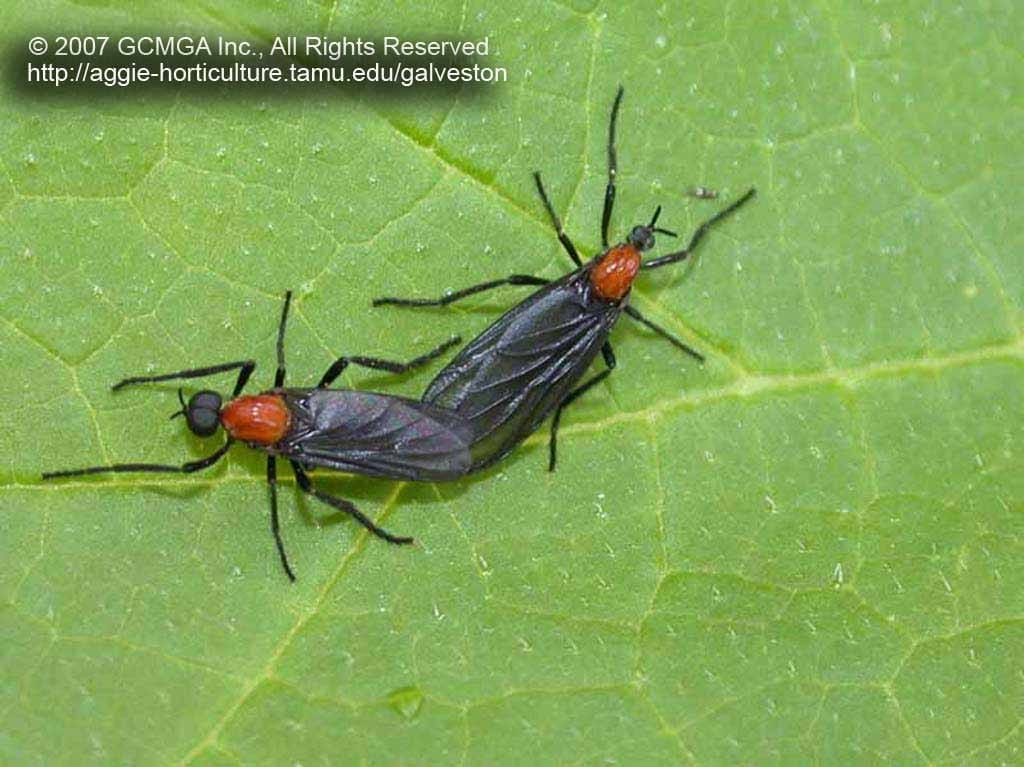Source(s): Will G. Hudson, Extension Entomologist, The University of Georgia
Lovebugs are small black flies with red thoraxes. They are members of the family Bibionidae. Several species of this family are native to the southeast, but lovebugs, Plecia nearctica, are relatively recent invaders from the west.
Southern Louisiana experienced flights of lovebugs during the 1920’s. First reports of their presence in Florida were made in 1947 from Escambia County. Since that time, flights have progressively moved southward. In 1974, specimens were collected in the Homestead area of south Florida. Lovebugs also have moved northward and infest parts of all states bordering the Gulf of Mexico, as well as Georgia and South Carolina.
Two flights of lovebugs occur each year. The spring flight occurs during late April and May, with a second flight during late August and September. Flights extend over a period of 4 to 5 weeks but individual adults live only 2 – 3 days. Mating takes place almost immediately after emergence.
Female lovebugs lay from 100 to 350 eggs. Larvae (immature stages) feed on decaying plant material, particularly in damp areas. They perform a beneficial function by helping recycle organic matter. After larvae mature, they pupate at the soil surface.
Lovebugs do not sting or bite. They feed on the nectar of various flowers. Adult flights are restricted to daylight hours (generally beginning around 10 AM) and temperatures above 68EF. The adults tend to congregate in open, sunny areas and are attracted to some components of automobile exhaust. At night, lovebugs rest on low-growing vegetation.
Lovebugs are a considerable nuisance to motorists. They congregate along highways and splatter on the windshields and grills of trucks and automobiles. Vision can be obscured, and the bugs can clog radiator fins causing vehicles to overheat. A screen placed in front of the grill will keep the radiator fins from clogging, and will protect the front of the car. Splattered bugs should be washed off as soon as possible. Soaking for several minutes with water makes the mess easier to remove. When the remains are left on a car for several days, the finish may be permanently damaged.
A number of insecticides have been evaluated for effectiveness in controlling lovebug larvae and adults. Most of the insecticides were effective in controlling the adults, and several controlled the immature stages. However, insecticidal control of the lovebug is impractical because infestations occur over such a vast area and adults are so mobile that retreatment would be required every few hours to keep a roadway clear. Most commonly available household insecticides will control adults in confined areas such as entryways and porches. Your county Extension Agent can help with the choice of materials for this purpose.
Lovebugs are not without enemies in nature. Larvae are found in extremely high numbers in pastures and other grassy areas, and make attractive prey for certain bird predators including robins and quail. Laboratory studies using invertebrate predators found in lovebug-infested pastures indicated they were voracious predators also. These included earwigs, beetle larvae and a centipede.
Lovebug populations may vary considerably from year to year, and some years are much worse than others. The reasons for these fluctuations are not known.
Center Publication Number: 197
- Fall Armyworms - September 24, 2013
- Lovebugs - September 24, 2013
- Two-Lined Spittlebug - September 22, 2013